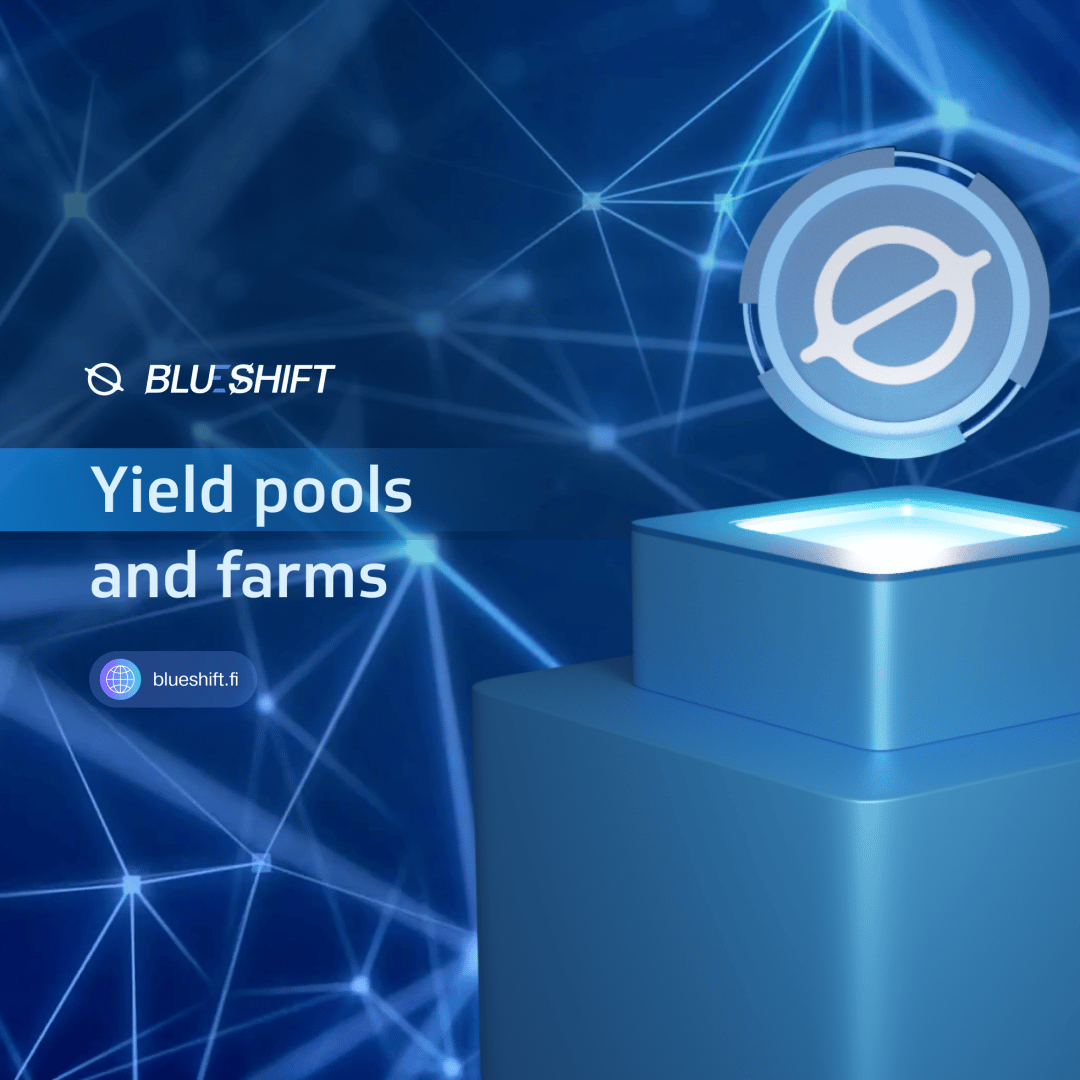Passive revenue generation through Yield Pools and Farms
Jun 23, 2022

In addition to swaping tokens or placing them in portfolios, users can earn tokens themselves through yield pools and farms! This allows Blueshift users to benefit from significant upsides and returns!
So let’s dive right into these amazing mechanisms.
Yield pools are decentralized liquidity mechanisms that were created to incentivize holding a specific cryptocurrency. This incentivization is manifested by providing users that ‘staked’ a cryptocurrency into a Yield pool — with additional tokens!
Farms are likewise a very similar concept, except in Farms, users stake the so-called LP tokens to get additional cryptocurrency.
In essence, both Farms and Yield Pools are Smart Contracts that exist on the blockchain and users commonly interact with them through the website of a specific project — although a more veteran user can interact with a Yield Pool or Farm directly through the blockchain itself.
The same is true for Blueshift — on the Blueshift website users can easily stake $BLUES with a click of a button and start receiving $BLUES on a monthly basis. A dream come true for everyone seeking passive income!
The Blueshift team allocated a grand total of 45 million BLUES tokens for staking rewards which are provided via Yield Pools and Farms — to ensure the stability of the Blueshift ecosystem. This might sound like a large number, but when one takes into account that $BLUES total initial supply is 100 million — one can truly appreciate Blueshift’s team dedication to the community and providing value to $BLUES holders.
Staking $BLUES in yield pools provides approximately 150 % APR. This parameter can be changed via a community vote — which means it can even be increased!
At the moment two different Yield pools are available — the manual pool with 150 % APR and the automatic pool with 148 % APR. The manual pool is utilized by manually harvesting and adding the harvested BLUES into the yield pool whilst the automatic pool does this automatically. This results in better compounding rates, however with the manual pool users get to time their taxable events which in some states are defined as any crypto withdrawal, and other reasons as well.
Rewards for staking LP tokens into Farms are not as clear cut — as it currently provides APY between 69% and 696%. The APY percentage varies depending on the chosen farm as well as liquidity conditions present in liquidity portfolios connected to their respective farms.
Farms and Portfolios
The purpose of Farms is to incentivize providing liquidity into Liquidity Portfolios. Even though providing liquidity into Liquidity Portfolios already generates passive income for the providers — for many it is still deemed a too risky endeavour. This is where Farms come into play. Luckily, with Blueshift — the risks of Liquidity Provision are significantly reduced, whilst the benefits of Farms are still in full throttle and unaffected by the technological approach of the Blueshift platform.
Farms generate additional APY for Liquidity Providers and hence incentivize users to provide liquidity that otherwise wouldn’t — by having a risk-to-benefit ratio that is just too good to pass on.
This extra incentivization is extremely important for an ecosystem because Liquidity Providers are the backbone of Decentralized Finance. Without Liquidity Providers there would be no AMMs and hence — the practical DeFi as we know it today — would not exist.
The incentivization mechanism works in the following way: Liquidity Providers receive so-called LP tokens — for providing liquidity to Liquidity portfolios. Once they have received the LP tokens, they can be staked into their respective Farms to generate additional cryptocurrency. Each liquidity portfolio has different demands for liquidity which is why every Liquidity Portfolio has its own individually assigned Farm with individually assigned LP token staking rewards. As previously stated — these rewards vary as the market conditions change.
At the moment there are eight farms available:
- Ecosystem Index | powered by Celer — APR 407%
- DeFi Index — APR 379%
- Top Metaverse Index — APR 352%
- Stablecoin Index | powered by Celer — APR 649%
- Occam Index — APR 218%
- Multichain Index — APR 70%
- Blueshift Index — APR 117%
- 3port Index APR 99%
*APR percentage values on June 21st
The number of Farms is a direct consequence of the number of portfolios as each portfolio has its own respective Farm where one can stake the LP tokens of the specific portfolio.
All of this is certainly impressive for today’s perception of a good passive income — even in crypto terms, however, let us consider the tokenomics that back these incredible mechanisms.
Tokenomics
The Farm and Yield Pools staking rewards are provided in $BLUES which is why it is imperative for Blueshift users to understand where these tokens come from as well as other parameters and mechanisms connected with the tokens supply inflation or deflation.
The Blueshift tokenomics type is inflationary with a hard limit, wherein tokens are minted every block — with a monthly decrease in block rewards.
The minting speed started at ~0.06 BLUES per second and since then it is decreasing with a monthly factor of 0.96. These are initial parameters and they will be able to be modified by the community via the DAO at a later stage.
The community will be able to modify all Blueshift ecosystem parameters, aside from parameters set out by the tokenomics table, including the ratio of block rewards provided for liquidity provision and staking.
As mentioned previously — the amount of BLUES tokens allocated for Yield pools’ and Farms’ rewards equate to approximately 45 million BLUES tokens. That is where the rewards for ‘Farmers’ and $BLUES stakers are coming from — they are minted. This ‘tokenomics item’ is marked in the tokenomics table as ‘Ecosystem Development Fund’ — and it has a vesting period of 3 years.
There is more to Blueshift tokenomics than meets the eye. Even though the tokenomics type is inflationary, there will be a manual deflationary mechanism in the form of surplus auctions.
To be more specific — the accumulated Blueshift protocol fees will be exchanged for $BLUES tokens on surplus auctions where token holders can bid their $BLUES tokens to receive the fees. After the auction has ended, the protocol will burn the tokens received from the winning bidder.
The first auction and burn event has still not occurred — but it will in the near future! This will be without a doubt a very exciting event for the Blueshift community!
To make sure you don’t miss it, and other important announcements, news and developments such as the most recent Tokenomics change — follow Blueshift’s Twitter page and join Blueshift’s Discord!
Previous

